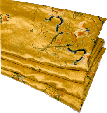
|
Spice
trading was conducted largely by sea routes with stops along ports in China, the East Indies (Spice Islands), India, the Middle East into the Mediterranean, and extending to ports in Genoa, Venice, and on to Britain. At one t
ime Middle Eastern peoples valued spices as highly as gold. In Europe, where meat was often preserved in nothing more than salt, spices became a mandatory ingredient to flavor the meat in order to make it palatable. Pepper became a precious commodity an
d was used as money both in the West and East. Cinnamon is said to have once been more valuable than gold. Trade in nutmeg , cloves and cinnamon in the Spice Islands enabled the Dutch to become extremely wealthy. When the Portuguese discovered a sea ro
ute around the tip of Africa to the Spice Islands in the 15th century, traditional spice trade routes were altered forever.
View trade route
|













![[English]](../simages/english.gif)

![[French]](../simages/french.gif)

![[Credits]](../simages/credit.gif)

![[Feedback]](../simages/feedback.gif)